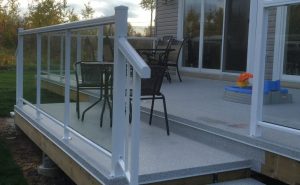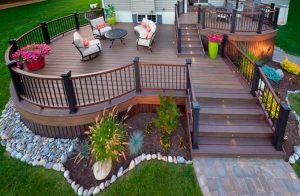It’s not too often that an industry such as deck building can say with all confidence that a newly introduced product will truly be a momentous change. Not since 2009 when we saw the desperately needed International Residential building Code update to address the construction of decks. And then the introduction of second-generation capped composites have we seen a significant change such as this: pressure-treated Laminated Veneered Lumber or LVL joists for outdoor deck construction.
WHAT IS LVL
LVL is not new, it has been a staple of indoor and unexposed building construction for years specifically for headers, beams, rim boards, and columns. The beauty of LVL is it is built to engineered specifications in a factory. Laminated veneered lumber provides uniform widths and strength, as well as the elimination of shrinkage and twisting typically found in traditionally milled, forest-grown wood lumber. With LVL now being offered with pressure treatment, it is approved for outdoor decks. This offers the professional deck builder the ability to eliminate the waves that can occur in traditional lumber framed decks.
TYPICAL DECK CONSTRUCTION PRIOR TO LVL
Prior to 2019, the only option for a deck that is as flat as the floors inside your home was steel frame deck construction. While this is a fine frame upon which to place your 30 to 50 year warrantied decking, it has the disadvantage of increasing the cost of the deck by 30% as well as limiting some design options. After that, there was the option of #1 select fir joists. While this is a better option than the common lumber grade of #2 or better, it still has milling discrepancies in width, degree of moisture. So even paying for premium kiln-dried lumber, you will still have the minor waves you see with #2 lumber and pressure treated.
Up until now, it has been our opinion and practice to build with pressure-treated fir lumber and minimize levelling discrepancies in two ways:
- The proper crowning of joists (all up)
- Grading the joists prior to installation.
Both help the minor waves that can occur. The problem is we are unable to ensure perfection due to moisture content. We may take all the proper and professional installation steps for a very flat deck and still end up with waves down the road as the lumber dries. It is on that same fact we do not plane the joists after installation. The deck may be glass flat the day of installation, but over time, as the joists dry they can shrink or crown unevenly. Unfortunately, we as deck builders cannot dictate what the result of the reduction of moisture content in wood joists, pressure-treated or not, will be. This brings us back to the pressure treated LVL. The change in this game is the “pressure treated” part of the LVL.
WHY ARE LVL FRAMED DECKS BETTER
To a professional deck builder like Ridgeline Decks, LVL removes the minor uncontrolled waviness that can happen on otherwise perfectly constructed decks. We no longer must live with these even though they may be hardly or not even at all perceptible to the customer or untrained eyes. Those of us builders that truly want to give the most return on the customer’s investment in their deck and outdoor living enjoyment now can give a steel frame strength, longevity, and most of all sheet-of-glass-smooth and stiff deck surface at more than half the cost of the steel frame construction. With most if not all modern composite and PVC deck boards now pushing the 50-year plus warranty, doesn’t it make sense to build a true 50-year frame to put them on? To do anything less would be like putting a filet mignon on a paper plate.




